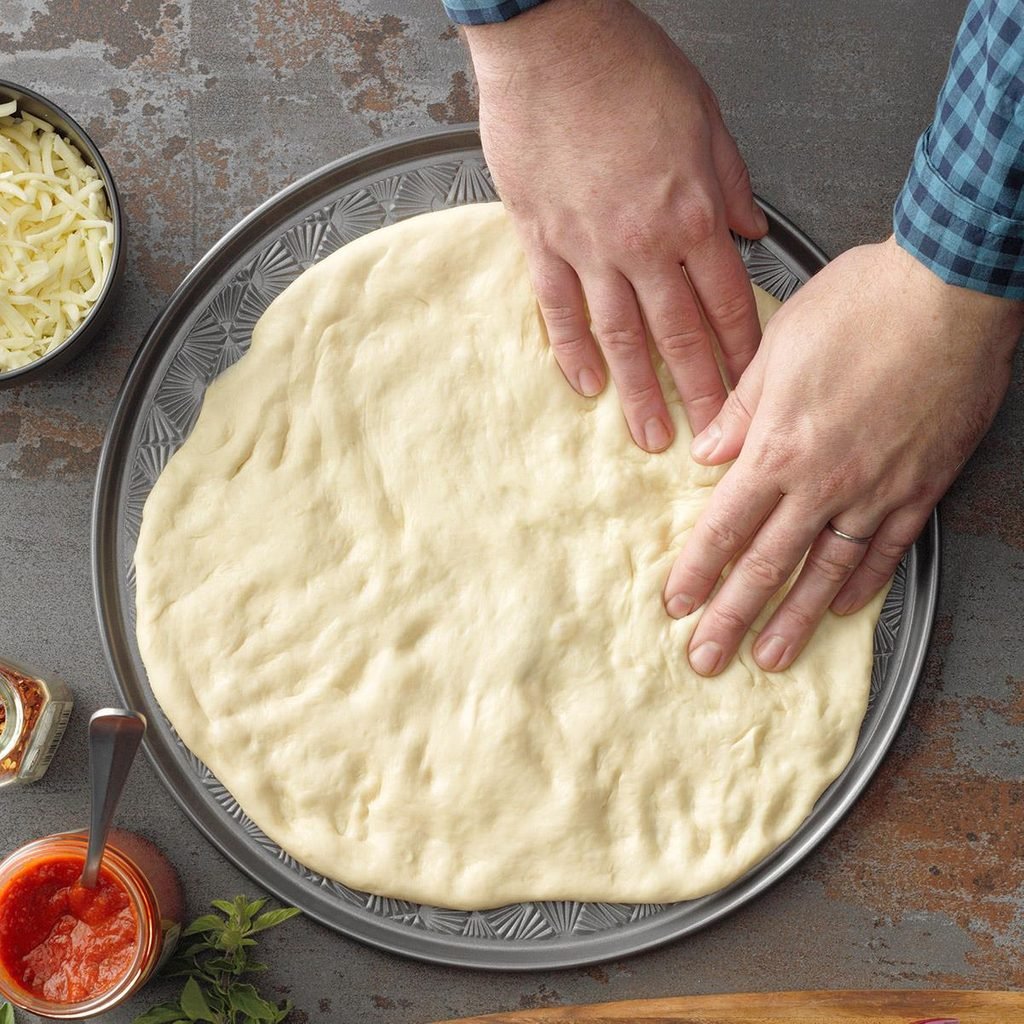Knowing how to make pizza dough is essential. Sure, ordering from a pizza chain is a familiar way to kick off the weekend, but it’s surprisingly easy to whip up our Test Kitchen‘s pizza dough recipe. Believe it or not, this dough comes together in about 30 minutes, and you can bake it after a short proof. It’s almost as fast as your go-to frozen pizza! The best part: You don’t need any special tools or ingredients.
Pizza Dough Ingredients
- Flour: You can use all-purpose flour in this pizza dough recipe. If you’re willing to go the extra mile, use double zero flour (aka “00 flour”). This flour is usually imported from Italy and will give the dough a noticeably silkier texture.
- Active dry yeast: This type of yeast has to be proofed—or activated in warm water—before using. Make sure to check the expiration date on the package. Expired yeast isn’t as effective, and the dough will not rise properly.
- Water: Water temperature is critical with yeasted dough recipes. It must be hot enough to activate the yeast but not so hot that it can kill it. For active dry yeast, the ideal temperature is 110° to 115°F.
- Salt: Salt does more than just add flavor. It strengthens the dough’s gluten structure so the crust will stretch without tearing. Salt also slows down fermentation, so the dough won’t rise too quickly.
- Sugar: Sugar isn’t strictly required for pizza dough, but it speeds up the proofing process. It provides the yeast with the nutrients it needs to grow. You can swap in honey or agave nectar if you don’t want to use sugar.
- Oil: Oil helps the dough stretch more easily. It also aids with browning, so your pie will crisp up to a gorgeous golden color. Choose aromatic olive oil to add extra flavor to the dough.
- Dried herbs: Herbs like dried basil, oregano and marjoram are optional, but they add fantastic flavor that pairs well with pizza sauce and toppings.
Directions
Step 1: Proof the yeast
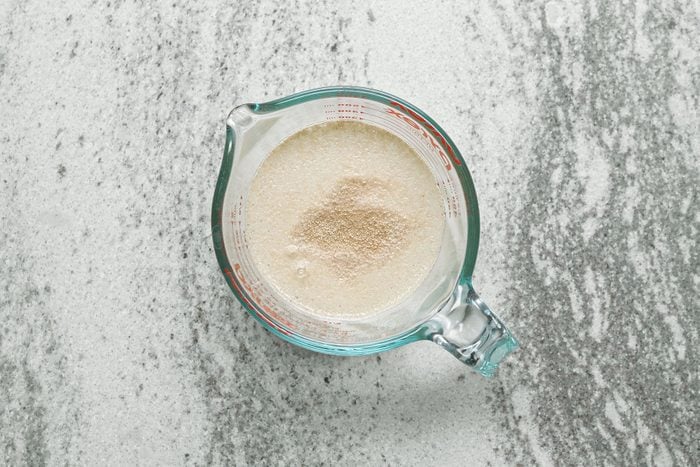
To proof yeast, mix the warm water and 1 teaspoon sugar in a small bowl. Add the active dry yeast and whisk until dissolved. Let stand until the mixture is frothy and bubbles form on the surface.
Step 2: Make the pizza dough
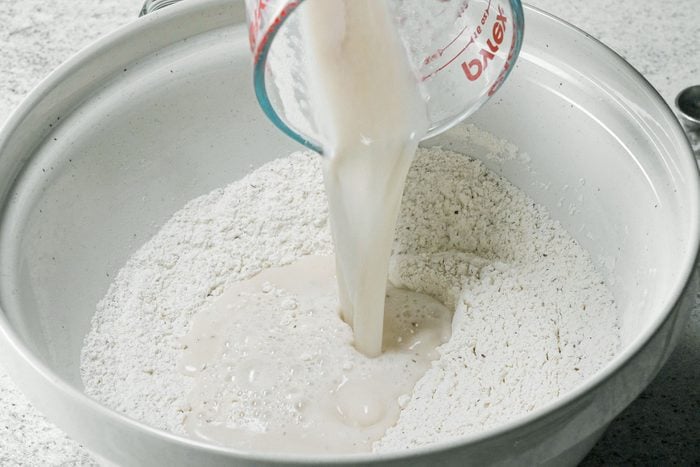
In a large bowl, whisk 3 cups of the flour with the salt, remaining 1 teaspoon sugar and, if desired, dried herbs. Once combined, make a well in the center of the flour. Add the yeast mixture and oil. Stir until smooth. Add enough remaining flour to form a soft dough.
The dough has the right amount of flour when it’s soft but not sticky.
Step 3: Knead the dough
Turn the dough onto a floured surface, and knead until the dough is smooth and elastic, six to eight minutes. For a hands-off method, knead the dough with a stand mixer for about three minutes. Add more flour to the surface as needed.
Editor’s Tip: Gently poke the dough to see if it’s finished. The dough ball should spring back to its original shape. (Psst: Here are other great tips to tell if you’re kneading dough the right way.)
Step 4: Rest and chill
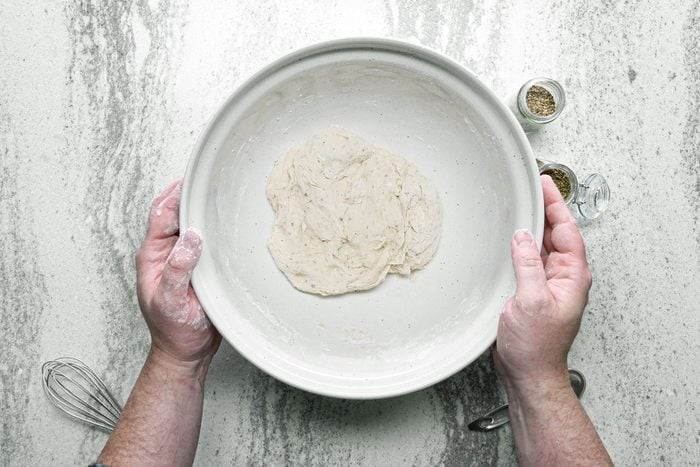
Place the dough in a large greased bowl. Turn the dough once to grease the top. Cover it, and let it rise in a warm place for 30 minutes. Then, transfer the bowl to the refrigerator. Chill overnight.
Editor’s Tip: Cold fermentation in the refrigerator improves flavor and makes the dough easier to stretch. But if you forgot to plan ahead, skip the overnight chill.
Step 5: Let dough come to room temp
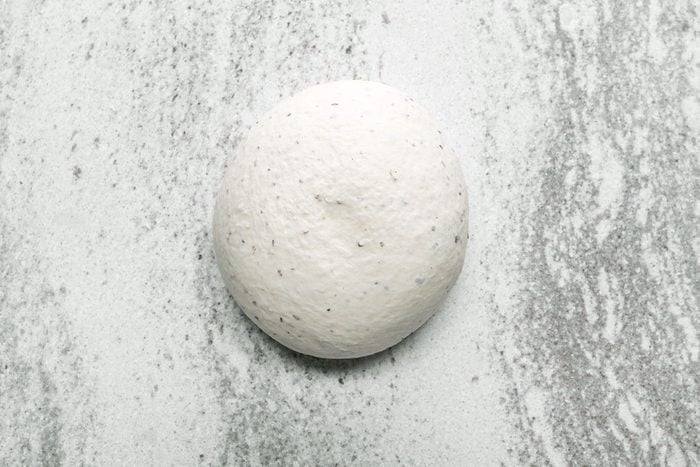
Allow dough to come to room temperature before rolling.
Editor’s Tip: Room-temperature dough is much easier to work with! It will stay in place as you stretch it instead of springing back into a smaller circle.
How to Stretch Pizza Dough
Punch the dough down to release the air. Then, turn it out onto a work surface, and shape it into a large ball. Use a dough cutter to separate the ball into two pieces.
From there, it’s time to form the crust. You can roll the dough with a rolling pin, but rolling pins can make the dough tough. This pizza dough recipe is very malleable, so we like to stretch it by hand. That creates a lighter, airier crust.
Transfer the dough to a 12-inch square of parchment paper or a 12-inch pizza pan. Use your palms to flatten the dough into a large circle. Gently pull and stretch the edges as you go. If the dough won’t stretch easily, take a break and let it rest for a few minutes.
How to Make Pizza with Homemade Pizza Dough
Use this pizza dough to make your favorite pizza recipes. It can make several types of pizza, but the cooking method varies slightly. Here are our top recommendations for how to use homemade pizza dough.
- Use a pizza pan: Prick dough thoroughly with a fork. Bake in a 400° oven until lightly browned, 10 to 12 minutes. Then, top the crust with pizza sauce (check out our Test Kitchen’s best store-bought pizza sauces for a shortcut), cheese and your pizza toppings. Bake until golden brown and the cheese is bubbling, 12 to 15 minutes.
- Deep-dish pizza in a cast-iron skillet: To make a deep-dish pizza, roll the dough out into a 15-inch circle. Transfer to a well-greased 12-inch heavy ovenproof skillet or round baking pan. Let the crust drape over the edge. Add sauce, cheese and toppings. Bake at 400° for 20 minutes. Sprinkle on additional cheese, and bake until the crust is browned, 10 to 15 minutes longer. Let stand for 10 minutes before slicing.
- Bake in an outdoor pizza oven: Outdoor pizza ovens like the Ooni pizza oven replicate the atmosphere of classic brick ovens. That gives homemade pizza a perfectly crisp edge and a gooey, cheesy top. They’re also a lot hotter than indoor ovens, so you don’t have to par-bake the dough. Simply put the toppings directly on the raw dough. Then, cook the pizza according to the oven’s instructions. Depending on the pizza oven and its temperature setting, it may only take one to two minutes.
- Grill your pizza: Lay down a pizza stone and cook the pizza on top. Some grills have special features for making wood-fired pizza.
Other Uses for Homemade Pizza Dough
- Calzones: Calzones are essentially pizzas folded in half, sealed and baked. You can use this homemade pizza dough to make quick calzones or tempting pizza pockets stuffed with tasty fillings.
- Stromboli: Roll this pizza dough with fillings to make stromboli recipes. These Italian-inspired rollups make a great appetizer!
- Flatbreads: Tomato sauce and mozzarella are just the start. Roll out pizza dough into an elongated shape and top with fresh ingredients. Get inspired by triple tomato flatbread and grilled elote flatbread.
Can you make pizza dough ahead of time?
You can make this pizza dough recipe up to two days in advance. (After two days, the dough can become over-proofed, and it won’t have any rise left for the oven.) Store it in an airtight container in the refrigerator. Yeast doughs continue to rise as they sit—even in the fridge—so leave room in the container for the dough to expand. When you’re ready to use, let the dough sit on the counter for 30 minutes to warm up.
Can you freeze pizza dough?
Yes, and pizza dough freezes well. The yeast basically goes to sleep in the freezer—don’t worry, that’s a good thing.
To freeze pizza dough, place each portion of dough in an airtight container. Freeze for up to one month. The best way to thaw pizza dough is in the refrigerator overnight. If you’re running short on time, thaw dough in a bowl of cold water for one to two hours. Make sure the dough is in a tightly sealed bag to keep the moisture out and change the water every half hour.
Tips for Homemade Pizza Dough
What is the best flour for homemade pizza dough?
You can use all-purpose flour or bread flour for homemade pizza dough, but 00 flour is our top choice. There’s a reason this type of flour is sometimes labeled “pizza flour!” This finely milled flour has a texture similar to cornstarch. That makes the dough super smooth, elastic and easy to work with.
How long should pizza dough rise for?
This pizza dough recipe only needs to rise for 30 minutes, but we recommend chilling it in the refrigerator overnight. Cold fermentation in the refrigerator produces a dough with incredible flavor. The extra resting time also makes the dough easier to stretch.















